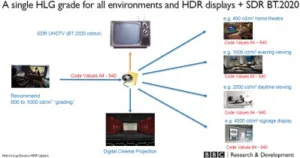 Andrew Cotton from the BBC’s R&D department is one of the developers of the HLG EOTF and gave an update on the development of support for the technology as one of SES’s excellent technical talks during SES. Sadly, clashes meant that this was the only one we got to this year, but if you attend IBC, it’s worth registering.
Andrew Cotton from the BBC’s R&D department is one of the developers of the HLG EOTF and gave an update on the development of support for the technology as one of SES’s excellent technical talks during SES. Sadly, clashes meant that this was the only one we got to this year, but if you attend IBC, it’s worth registering.
Cotton started by summarising that HLG is a scene-referred system like BT.601, Rec 709, Sony’s Slog3, PanaLog etc and “the camera has primacy” he said. On the other hand, the PQ EOTF (used in HDR10 and Dolby Vision) is display referred, like cinema and the display EOTF has primacy.
HLG is based on the relative light in the scene as viewed by the camera and that means that no metadata is needed and the BBC says that with PQ you need metadata and you really need dynamic metadata for good performance. However, even static metadata is tricky to manage at programme boundaries, especially in live production.
Fundamentally, scene light and display light are different.
With HLG, there is a fixed OETF and a variable EOTF. Although the basic curve is the same, there need to be gamma offsets to compensate for adaptation of the eye in different lighting situations and the adjustment is in ITU BT.2390. When BT2100 came out the degree of adjustment wasn’t understood, but since then more work has been done.
 HLG has offsets to deal with the accomodation of the eye in different lighting. Click for higher resolution
HLG has offsets to deal with the accomodation of the eye in different lighting. Click for higher resolution
Detail in the black is the big issue in dealing with adaptation. To improve this, you can increase the contrast in the display or reduce room brightness. If you have detail visible in the black in bright conditions, you need to change the gamma so that it is not too prominent in dark conditions.
HLG has now been tested in a wide range of brightness conditions from digital cinema projection to as much as 4,000 cd/m² for digital signage applications and if the offsets are applied, there is good performance.
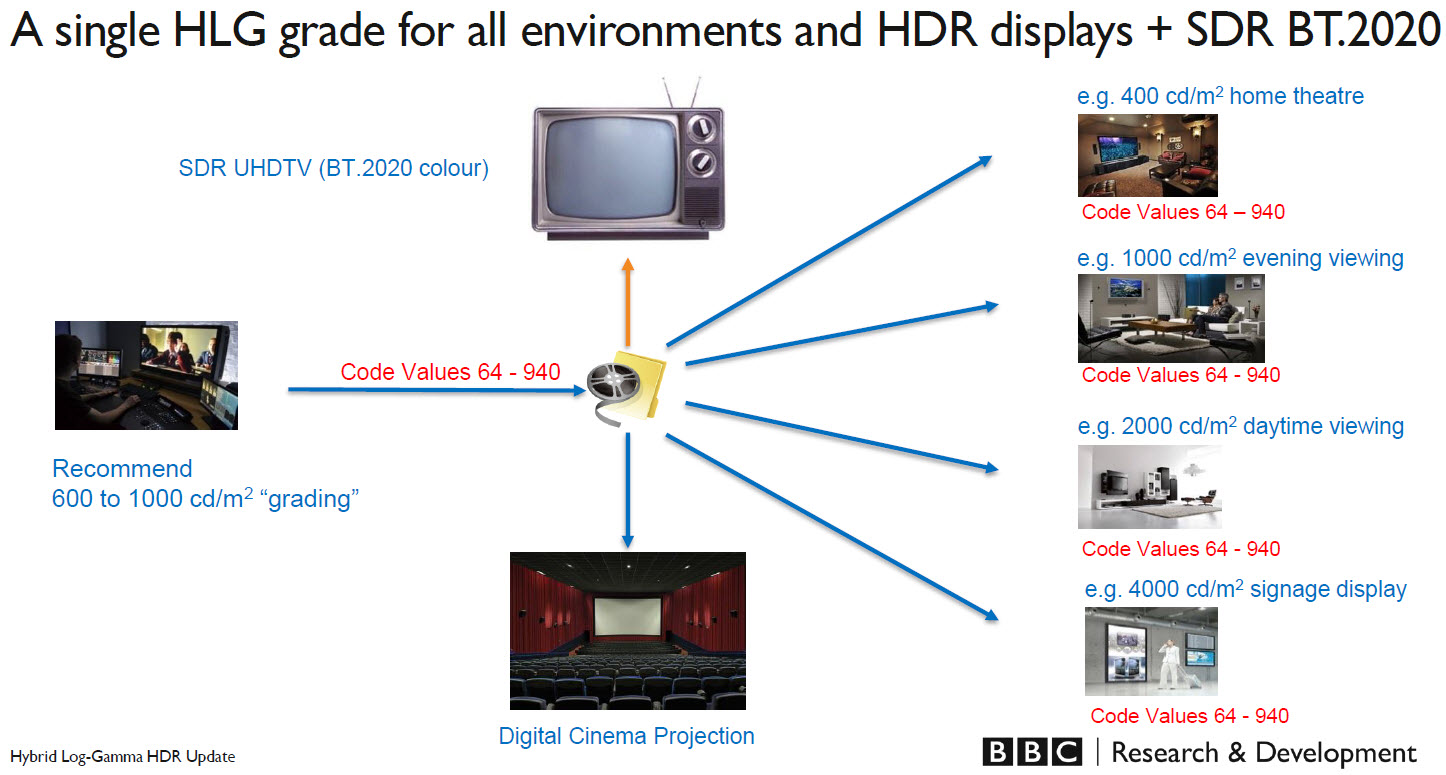 HLG supports a wide range of brightness – up to 4000 cd/m² for signage and down to 100 for cinema. Click for higher resolution
HLG supports a wide range of brightness – up to 4000 cd/m² for signage and down to 100 for cinema. Click for higher resolution
HLG uses the Rec. 2020 colour primaries – so to see it you need to meet the requirements of UltraHD Phase 1.
For cinema, which typically has a peak brightness of 100 cd/m² (at least until LED replaces all the projectors – Man. Ed.) you need to use a different gamma as the original HLG curve in BT2100 was for displays from 400 to 4000 cd/m² and, further, the colour space needs to be changed to be mapped to the DCI XYZ colour space. In this low level of darkness, some adjustment of the curve is needed.
Mastering is recommended in the range of 600 to 1000 cd/m² and tests have shown that content mastered at that level looks good in the full range of brightness conditions from 100 to 4,000 cd/m² as long as the offset is applied.
 The HLG Timeline – Plugfests have shown continued improvement. Click for higher resolution
The HLG Timeline – Plugfests have shown continued improvement. Click for higher resolution
Cotton then looked at the timeline. In November 2016, YouTube said that it would support HLG and PQ. The DVB ‘Blue Book’ came out in November 2016 and HDMI 2.0b was published in Dec 2016. That was a critical moment and was followed by the standardisation as ETSI TS101 154 v2.3.1. In May, the ATSC A/341 was included in ATSC 3.0.
Production Also Needs Consideration
However, the development of these distribution standards are necessary, but not sufficient to ensure that HLG is successful, there is work to be done in the production side.
Format conversion is essential. For example, if the switcher/mixer is HLG, then everything needs to be converted from SDR or PQ. Football match may need 24 cameras and specialist cameras are often SDR, so format conversion will be needed as most productions will not have all its cameras with HLG in the short to medium term.
You also need to know what reference levels should be and how to control brightness in the scene. You also need to be able to measure the signal so you need test patterns.
Operational practices are being defined and the ITU is working on format conversion. The EBU is working on new monitor specifications for mastering monitors for HDR (and we’re checking for an update on this – Man. Ed.). SMPTE has developed a way of signalling HDR on SDI and that removes a barrier.
The German TV platform has been working on support in STBs and interoperability. The group conducted a plugfest in December 2016 and there were some problems with boxes and with some TV sets, but by June, Cotton said, the TVs were supporting HLG “very well”.
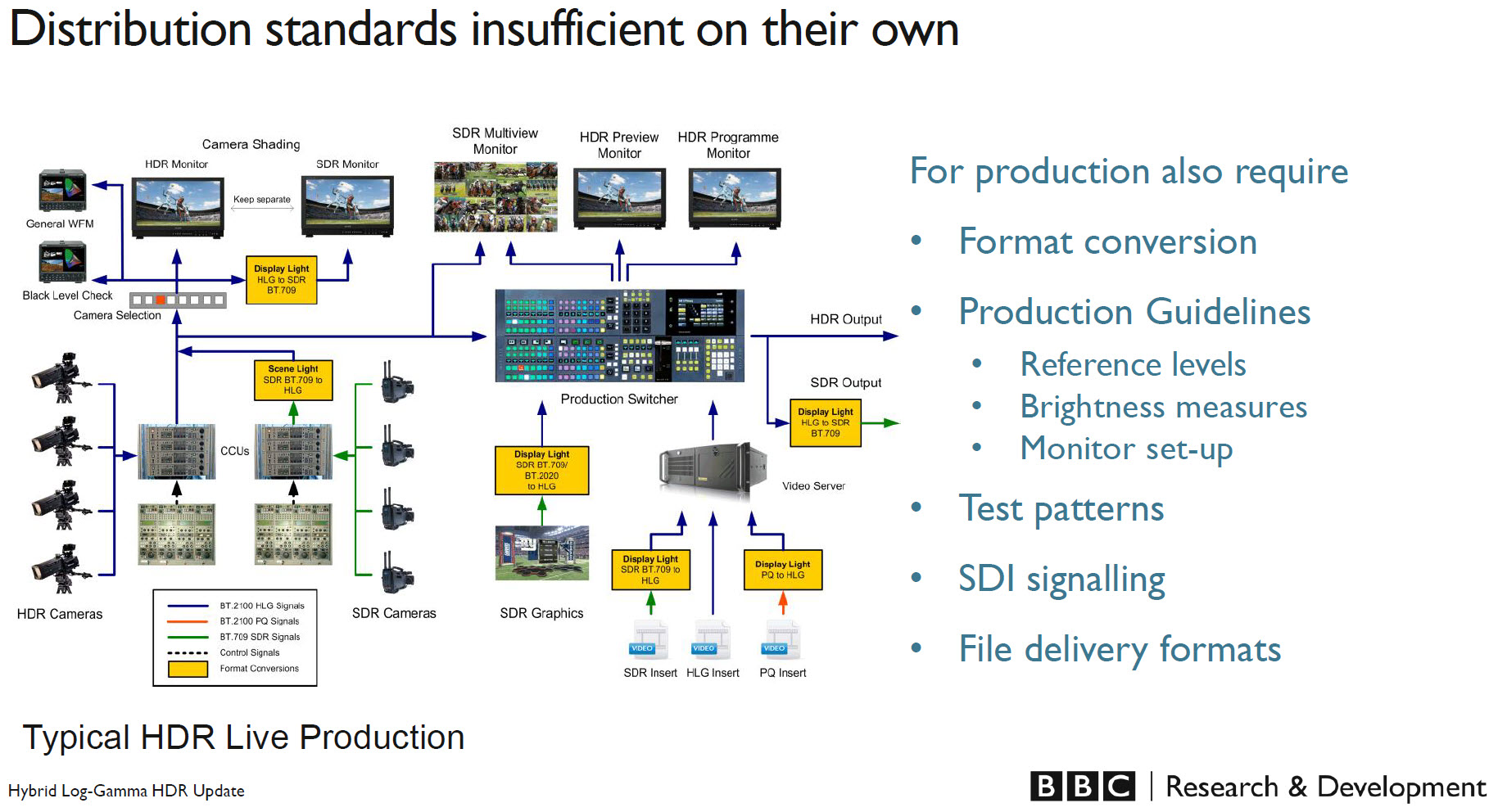 HLG Production will need good format conversion. Click for higher resolution
HLG Production will need good format conversion. Click for higher resolution
For HLG as the display gets brighter, the the image automatically gets lighter. You can grade in the dark, if you prefer, but it still looks OK in the bright light. With HLG, the range of specular highlights stays at around 2-3 stops.
In contrast, Cotton said, for PQ, the image brightness stays constant and there are 6-7 stops for the brightest displays.
So, Cotton said, there is a bridge condition at 1000 cd/m² and the images on PQ and HDR should look identical. That makes it a good level for mastering content that will be delivered using both systems.
There is an easy conversion from HLG to PQ at 1,000 cd/m² and the BBC did it for its first UltraHD Blu-ray as Blu-ray makes HDR10 support mandatory.
However conversion from PQ is slightly different. First you tonemap to 1000 cd/m² then you can convert to HLG. There is more than one way to tonemap and different people have their own ideas, Cotton commented.
The ITU-R is now looking at SDR to HDR mapping to try to maintain the ‘look’ of SDR. Cotton said that content owners of SDR often request no ‘stretching’ of the SDR look in order to preserve the original creator’s intent so there needs to be a way of mapping and this is basically maths, he said. The ITU-R has two approaches, one based on display light to keep the look the same and the other with scene light for matching SDR & HDR.
- There are three conversions being developed
- SDR to HDR ‘up conversion’
- HDR to SDR down conversion
- SDR to HDR to SDR ’round tripping’ and Cotton said that this is very challenging. Some compromises are needed as the best ‘down’ conversion is not the inverse of the best ‘up’ conversion.
The ITU-R wants to make this a recommendation rather than anything mandatory as although there will be a standard, the market is likely to develop better processes over time, it believes and there are lots of products already available.
It’s probably best to do format conversion at the broadcast side, but HDR channels that are simply full of up-converted SDR is not a good idea, Cotton said. SDR conversion is often needed for interstitials.
Cotton said that it will be a long time before the BBC will have a full channel of HDR, but on demand should be available in HDR relatively soon.
3D LUTs are relatively low cost and available and BBC R&D has technology available for licensing. (contact [email protected])
Production
Zebra stripes and other aids are needed for HDR and broadcasters will need new or upgraded waveform monitors. There has been an agreement that diffuse white is 75% of HLG which is around 200 cd/m² allowing 2-3 stops of headroom. This has been documented in TS 101 154 and by the UltraHD Forum. Using that level ensures a good SDR signal.
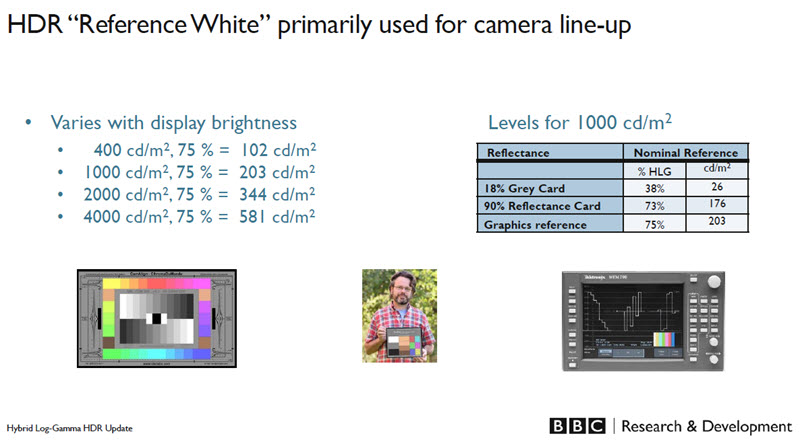
To match white on a current TV with the same in HLG, you need 2000 cd/m² peak for specular highlights (which reflects the issue that has been seen that HDR sets can look dim on SDR content – Man. Ed.)
A brightness meter is being developed – there was a demo on the EBU stand and work has been done to understand “annoying” and “not annoying” changes. Analysis was done to map subjective observations to objective and a table of ‘comfortable transitions’ was developed. Light to dark is as annoying as dark to light, it turned out in tests.
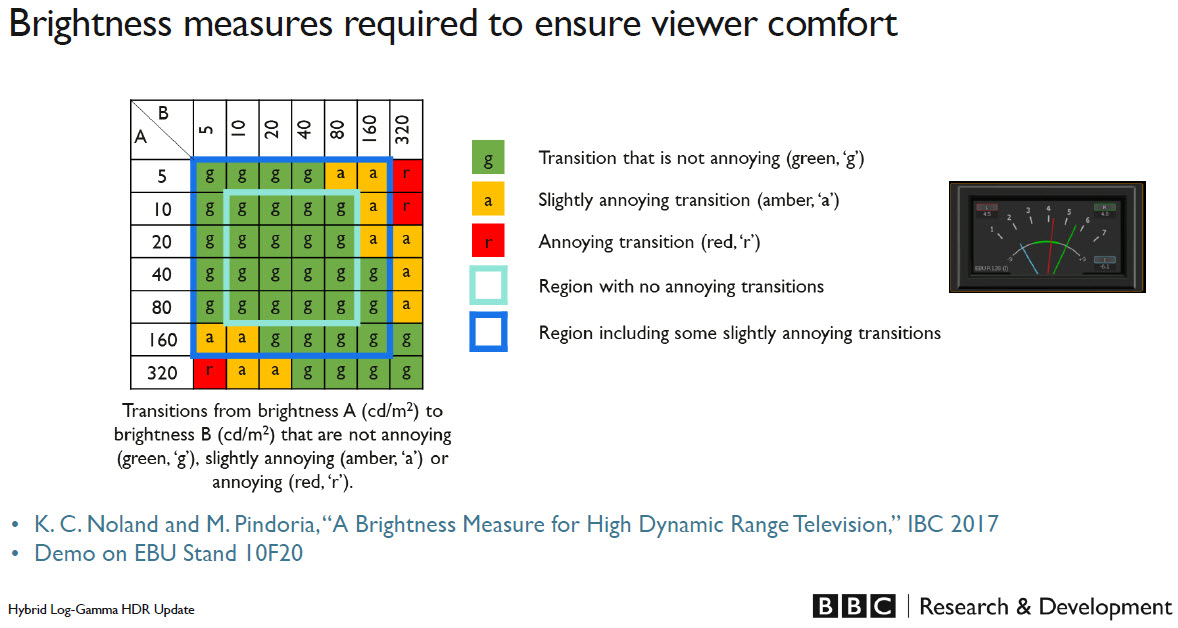 HLG can be annoying if the changes are too extreme. Click for higher resolution.
HLG can be annoying if the changes are too extreme. Click for higher resolution.
The majority of content creators will support both HLG and PQ (maybe more HLG than PQ, in Cotton’s view). Signalling of HLG and PQ on SDI is in progress and both are in H.264 and ProRes and other codecs are in progress.
There are ‘many’ TVs now in the market with HLG support and some brands have even put support into 2016 models via firmware upgrades.
At IBC, Panasonic announced that it is supporting HLG recording in the GH5 DSLR. YouTube and DaVinci Resolve both support the standard and there is now some HLG content on YouTube. However, there is a lack of recommendations on how to set up colours, e.g. flesh tones, so results have seen ‘mixed’ quality.
DaVinci Resolve seems to have three versions or two that support the EOTF.
HLG content is already on air in Japan and starting to appear through NHK and on the iPlayer.

